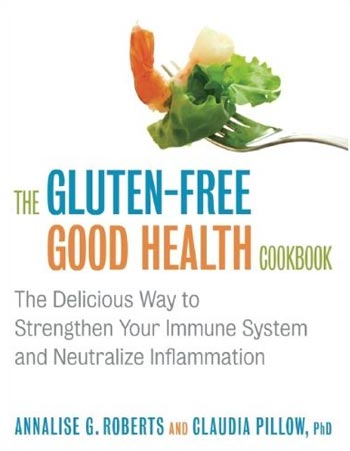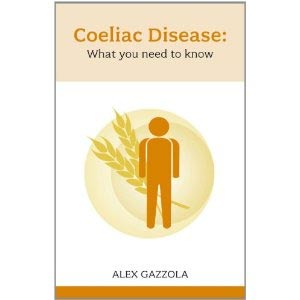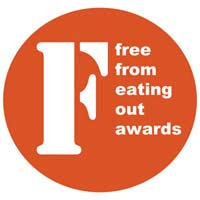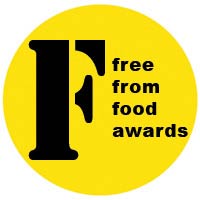
I recently received a copy of The Gluten-Free Good Health Cookbook: The Delicious Way to Strengthen Your Immune System and Neutralize Inflammation
, by Annalise G Roberts and Claudia Pillow, to review here.*
It’s always interesting to review books intended to help make life easier for coeliacs, and although I don’t agree with the authors about the need to neutralise acids in the body (the science of which I’m not going to discuss here), there is a lot of good sense and helpful advice in this book.
The thesis of the book (and parts of it do read like a thesis) is that many people have lost touch with what constitutes a healthy diet, and are eating too much refined processed food, particularly foods based on wheat and sugar – and that this has an adverse effect on the immune system. The authors recommend a mixed diet using a variety of fresh foods, particularly whole foods, including seeds, vegetables, fruit and fish.
No-one would suggest that the ‘breakdown of today’s daily diet’ suggested by the book is a healthy one; 10 pieces of bread, two sodas, a chocolate bar, a hamburger and a chicken breast, butter, fries, orange juice and an apple is a long way from Five-A-Day or the standard food pyramid. And the recommended mixed diet of a variety of fruit and vegetables and a range of different proteins (including beans, nuts and fish) and grains and grasses (rice, oats, millet and quinoa, for example) is one recognised by almost everyone as the ideal.
Not that the ideal is always easy to achieve (I’ve a weakness for red wine, black coffee and dark chocolate, myself) but there are some good suggestions in the book for how to move closer to the ideal. And the authors are realistic about what is achievable – I love the idea of leaving 5% of the daily diet for ‘goodwill’ (those little extras that you want but probably shouldn’t have).
Providing instructions on how to cook various things from scratch is helpful to those who aren’t sure how to begin to cook gluten free. Examples here include:
- how to make a gluten free white sauce
- how to make a soup
- how to make gluten free gravies
- the basics of how to roast, grill, fry etc
- some recipes for gluten free flour mixes
For people who aren’t used to cooking for themselves, this is invaluable instruction. And even those of us who are accustomed to cooking from scratch at home can learn something new from each new recipe book: a demi-glace, for example, is a new term for me, and I have discovered that the brand recommended by the authors is available here in the UK, at The Good Food Network.
The recipes vary from the very simple ‘how to make scrambled eggs’ or ‘how to compose a green salad’ to ‘how to make a citrus beurre blanc’ and ‘how to steam mussels’. What the authors do well is explain clearly and simply how to do all these things, so that whatever your level of expertise, they seem achievable. We’ll definitely try some of the recipes – the butternut squash and sage risotto appeals, as does the pesto brie pizza with jalapeno peppers. And the caramelised pineapple sounds delicious!
These recipes would appeal to anyone, not just coeliacs or the gluten-intolerant (and the authors do a good job of explaining the difference). In fact, using these recipes, you could eliminate a lot of gluten from your diet without noticing. Though as we know all too well, you do have to pay very close attention to eliminate it completely!
I’m not quite sure who the intended audience is: some parts of the book are quite technical, discussing macrophages and epithelial cells, among other things (and the footnotes and appendices are still more medically technical); other parts are clearly aimed at the brand-new cook. The latter are perhaps the most useful parts of the book, and a newly diagnosed coeliac could go straight to those to get started on the diet, thinking about the science later when they feel a little more confident.
Helpfully, the authors have also included US-measures to metric-measures conversion tables at the very back (this is something I often get confused over, because the UK and US pints are different measures!). Some of the brand recommendations are US specific, some of the recommended pantry ingredients are highly specialised (bottled clam juice isn’t a standard pantry item here, but everyone will have their own pantry favourites) and some of the language is US-oriented (cilantro and zucchini, for example, are what we’d call coriander and courgettes, and I think the closest thing we have to heavy cream is double cream, though the fat contents are different) but since the book is US-oriented, this is only to be expected.
However, I’m told that the book will be distributed in the UK, Australia and New Zealand, as well as in the US, and it is available to buy at Amazon.com (or Amazon.co.uk) as well as on the Agate Publishing website.
*Disclosure: I received a review copy, and this post contains affiliate links.
 |
I’ve written a book summarising what we’ve learnt over 20 years of dealing with the gluten free diet, and it might be just what you’re looking for. It packs the lessons we’ve learned into what I hope is a helpful and straightforward guidebook. It’s available on Amazon, as a paperback or for your Kindle… |




What a very thorough review. I’m not sure how many gluten-free cookbooks one person should have, but I think I’ll have to add this one to my wishlist.
Lucy
I bought a copy of this a few months ago and would have to agree completely with your review. I’m afraid I, too, have a weakness for red wine, coffee and dark chocolate. Just so you know, clam juice isn’t a pantry staple in the US either. :)
Wendy
Hi Heather and Wendy, thanks for commenting.
The perfect number of gluten free cookbooks? I don’t know either, but there’s always room for one more book in my house!
I was a little surprised to find clam juice listed in the book as a pantry staple, so I’m reassured that it isn’t standard in every US kitchen cupboard. I think I’d struggle to get my children enthused about it. But perhaps I’m just being unadventurous; my youngest is pretty keen on trying new foods, so maybe I shoudl give it a go…
Lucy
The only time I remember having clam juice in the house was when I was a teenager and my parents made Bloody Marys for their friends at brunch. Now that I have teenagers, I understand completely.